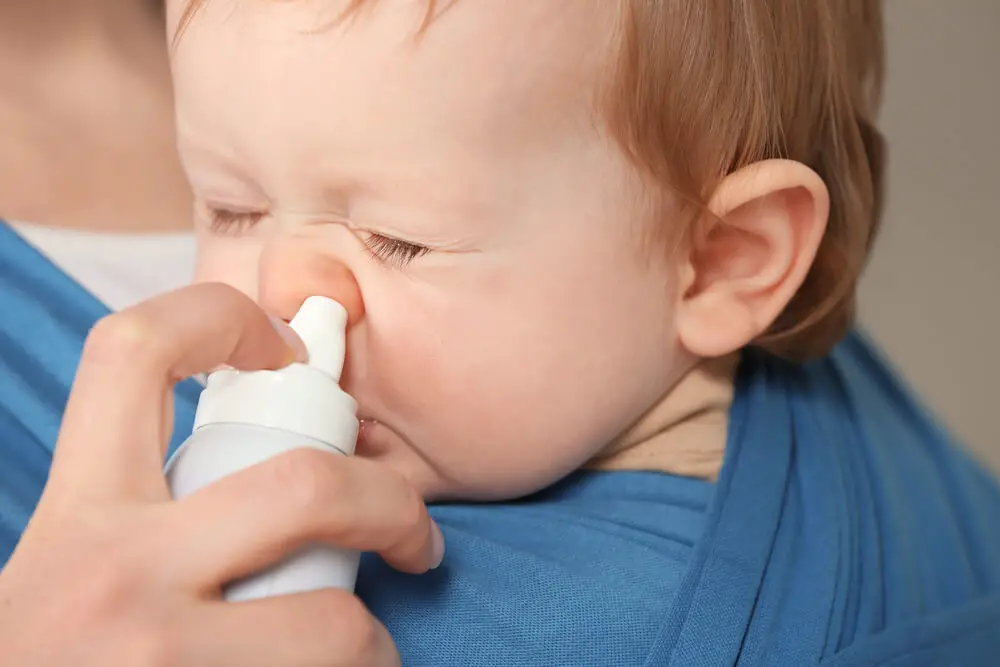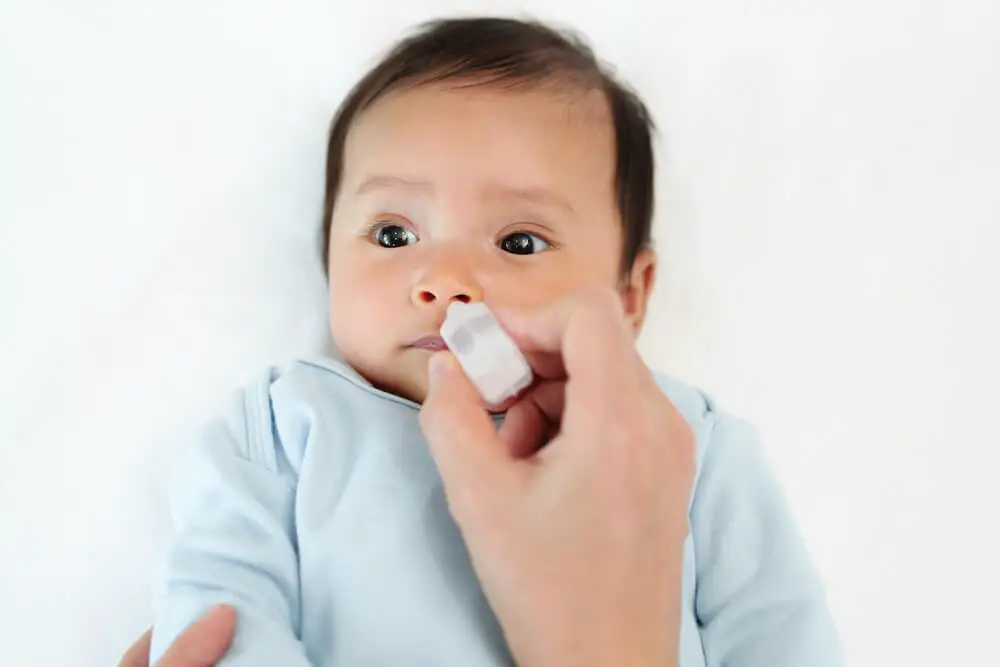As a parent, it’s hard to watch your baby struggle with nasal congestion due to a cold. You naturally want to help them find relief, but you may have concerns about administering nasal drops while they’re sleeping.
In this article, I will discuss whether can we put Nasal drops when the baby is sleeping and offer some guidance on how to do so safely.
Nasal congestion in babies can make it challenging for them to breathe, eat, and sleep comfortably. Nasal drops can be an effective tool in alleviating your little one’s discomfort, but you might worry about whether it’s safe to use them when your baby is sleeping.
It’s important to weigh the potential benefits against the risks, as well as understand how to properly administer the drops to ensure your baby’s safety.
Key Takeaways
- Nasal drops can help ease congestion in babies, but consider the risks and benefits before using them during sleep.
- Administer nasal drops carefully to ensure your baby’s safety and the effectiveness of the treatment.
- Alternative methods and medical attention might be necessary if congestion doesn’t improve or worsen.
Can We Put Nasal Drops When the Baby Is Sleeping?

Nasal congestion in babies can be a common issue, affecting their comfort and ability to breathe easily. As a parent, it’s important for me to understand the causes of nasal congestion and be able to identify the common symptoms and signs, so I can help my baby feel better.
Causes of Nasal Congestion
Nasal congestion in babies can be caused by various factors. One common cause is the common cold, which is a viral infection that affects the respiratory system. Babies’ immune systems are still developing, making them more susceptible to catching colds.
Other causes of nasal congestion can include flu, allergies, and infections, which can lead to inflammation and a buildup of mucus in the nasal passages.
Another possible cause of nasal congestion in babies is simply the accumulation of mucus due to their still-developing nasal passages. It’s important to remember that while these factors can contribute to nasal congestion, it’s not always a sign of a more serious issue.
Common Symptoms and Signs
There are several symptoms and signs of nasal congestion in babies, which can include:
- Runny nose: A clear or colored discharge from the nostrils is one of the most common symptoms of nasal congestion.
- Difficulty breathing: Congestion may cause difficulty in breathing, particularly when a baby is lying down or trying to sleep.
- Frequent sneezing: Sneezing can be a sign that the baby’s nasal passages are trying to clear out mucus.
- Irritability: As congestion makes it difficult for the baby to breathe, they may become irritable or fussy.
- Cough: A cough can develop as a result of the excess mucus dripping down the back of the throat.
- Fever: In some cases, a fever may accompany nasal congestion if it is due to an infection or flu.
It’s essential for me as a parent to monitor these symptoms in my baby and reach out to a healthcare professional if I’m concerned or if symptoms worsen. By understanding nasal congestion in babies and its causes and symptoms, I can ensure my baby’s well-being and comfort.
The Role of Nasal Drops in Easing Nasal Congestion

How Nasal Drops Work
As a parent, I know how important it is to help my baby breathe comfortably, especially during sleep. Nasal drops, such as saline drops or medicated nasal sprays, can be a great way to ease nasal congestion in a baby. They work by thinning mucus, which can make it easier for the baby to breathe and sleep more peacefully.
Saline nasal drops are particularly helpful because they’re a gentle solution that can be used safely and effectively. To use them, I simply place a couple of drops in each nostril using a nasal dropper. This can help loosen and clear any nasal congestion in my baby’s nasal passages, making it easier for them to breathe.
Different Types of Nasal Drops
There are various types of nasal drops available on the market. Here are some of the most common types I’ve encountered:
- Saline Drops: These are made from a simple saline solution, which is a combination of salt and water. They help to thin the mucus and moisturize the nasal passages, providing relief from congestion. Saline nasal drops are widely available over-the-counter and are generally regarded as safe for babies.
- Decongestants: Some nasal drops contain decongestant medication, such as pseudoephedrine or oxymetazoline. These can provide quick relief from nasal congestion, but they should be used with caution in babies and only under the guidance of a healthcare professional, as overuse can lead to undesired side effects.
- Nasal Steroids: Nasal steroid sprays, such as fluticasone or budesonide, can help reduce inflammation and swelling in the nasal passages. These are usually prescribed by a doctor and should only be used as directed.
In conclusion, using nasal drops can be an effective way to ease nasal congestion in a baby, allowing them to sleep more soundly. It’s essential to choose the right type of nasal drop and consult with a healthcare professional to ensure the best course of action when treating nasal congestion in babies.
How to Safely Administer Nasal Drops to a Sleeping Baby

Proper Positioning
When administering nasal drops to my sleeping baby, I make sure to position them correctly to ensure the drops reach the intended area inside the nostril. I gently lay my baby on their back with their head tilted slightly backward, either on the bed or on my lap. This angle allows the drops to enter the nostril and flow down the nasal passage with ease.
Correct Dosage and Application
Following my doctor’s instructions is crucial for administering the right dosage of nasal drops for my baby. I use a dropper to measure the exact number of drops recommended by the doctor. Gently, I hold the baby’s head steady and insert the dropper tip into the nostril without touching the sides, which prevents irritation. Finally, I carefully release the drops, making sure not to push too much air into the nostril. I repeat this process for the other nostril if needed.
Ensuring Hygiene and Safety
Maintaining proper hygiene is essential while administering nasal drops to my sleeping child. I always wash my hands thoroughly before handling the dropper or touching my baby’s face. Additionally, I keep the dropper clean by wiping it with a sterilized cloth or tissue after each use. Following these steps ensures the baby’s safety and minimizes the risk of infection.
By focusing on proper positioning, correct dosage and application, and ensuring hygiene and safety, I can successfully administer nasal drops to my sleeping baby in a secure and comfortable manner.
Possible Risks and Side Effects of Nasal Drops

Common Side Effects
In my experience, it’s important to be aware of the common side effects associated with nasal drops so that you can make informed decisions about their usage. Some people might experience nasal dryness, a mild burning or stinging sensation, or even inflammation in the nose. It’s also possible to go through nosebleeds, headaches, or trouble sleeping after using these drops.
Potential Risks
As a user of nasal drops, I should also be mindful of potential risks associated with their use. First and foremost, it’s crucial to pay attention to the active ingredients present in the drops. These ingredients can sometimes cause side effects such as weakness, irregular heartbeat, or bleeding in rare cases. Always consult with a healthcare professional if any of these more severe side effects occur.
Keep in mind that it’s important to use the nasal drops as directed and avoid overusing them, as this might increase the risk of experiencing these side effects.
Alternative Methods to Relieve Nasal Congestion in Babies

Hydration and Feeding Methods
I’ve found that one of the most effective ways to help relieve a baby’s nasal congestion is by keeping them well-hydrated. Proper hydration can help thin the mucus and make it easier for your baby to breathe. Offering breast milk or formula more frequently throughout the day may be beneficial. When giving babies older than six months water, it can be helpful to add a pinch of salt, as this can help break down the mucus. It’s also important to keep a close eye on babies during feedings to ensure they’re not struggling to breathe while eating.
Humidifiers and Steam Therapy
I have discovered that humidifiers and steam therapy are excellent at providing relief for nasal congestion in babies. By using a cool-mist humidifier or vaporizer in the baby’s room, the air becomes more humid, thereby helping to alleviate congestion. Steam therapy is another option that works well for me – I simply run a hot shower and sit with my baby in the steamy bathroom for a few minutes. This method helps to loosen up mucus and can quickly provide comfort for congested babies.
Physical Techniques
Physical techniques can make a significant difference in clearing a baby’s congested nose. One of the most common methods I use is a bulb syringe or nasal aspirator. Gently inserting the tip of the bulb syringe into my baby’s nostril and releasing the bulb creates suction that clears the mucus. Remember to clean the syringe thoroughly after each use. Another technique I found helpful is the use of a saline nasal spray to help loosen up the mucus before using the bulb syringe. Alternatively, dampening a clean cotton ball and gently wiping the inside of the baby’s nostrils can help clear the mucus and provide relief.
When to Seek Medical Attention
Monitoring Progress
As a parent, I always keep an eye on the overall health of my baby when they’re dealing with nasal congestion. It’s important to notice any changes in their condition and consult with a pediatrician if needed. Even when using nasal drops, it is vital to monitor the progress of my baby’s health.
Warning Signs
There are certain warning signs that warrant a call or visit to a pediatrician or a health care provider. I make sure to be vigilant of these signs, especially for my infants or toddlers:
- Trouble Breathing: If my baby appears to have difficulty breathing or is coughing excessively, it could indicate a more severe upper respiratory infection or other problems.
- Swelling: I watch for signs of swelling around the face, eyes, or in the neck area, which may suggest an infection or allergic reaction.
- Fever: A high fever can be a sign of an infection, such as sinus infections or ear infections. If my baby has a fever along with nasal congestion, I reach out to our pediatrician.
- Persistent cough: If my baby’s coughing doesn’t improve or worsens after using nasal drops, it could signify a more severe issue.
In any of these situations, I would consult a healthcare provider to get their professional opinion. If the symptoms become severe or if my baby shows signs of respiratory distress, it’s important to know when to bring them to the emergency room.
Remember, it’s always best to trust your instincts as a parent and contact a medical professional when you are concerned for your baby’s health.
Conclusion
I believe that using nasal drops for a baby when they are sleeping can be beneficial in relieving nasal congestion. It is important to be gentle and use the appropriate technique to avoid disturbing the baby’s sleep.
In cases of severe congestion, nasal drops can provide much-needed relief and help the baby breathe more comfortably, which is essential for their overall health and well-being. As a caregiver, it’s crucial to carefully administer nasal drops and to monitor the baby closely after treatment.
Although using nasal drops during a baby’s sleep can be convenient for the caregiver, it’s essential to consult with a pediatrician before implementing this treatment. They can provide guidance on the proper type of drops and the best method for administration.
Remember, always prioritize the baby’s safety and comfort when addressing their nasal congestion while sleeping. By following professional advice and the correct administration techniques, you can help your baby breathe easier and get the rest they need.
Frequently Asked Questions
How to administer nasal drops to a sleeping baby?
To administer nasal drops to a sleeping baby, I gently place the baby on their back with their head tilted slightly back. I hold the dropper above one nostril and, without touching the nostril, I squeeze the appropriate number of drops into the nostril. I then allow the baby to breathe in the drops for a few moments before repeating the process on the other nostril.
Are there side effects of saline nasal spray for babies?
Saline nasal sprays are generally safe for babies. However, some may experience mild side effects such as a runny nose or sneezing. If you notice any unusual or severe reactions, consult with your pediatrician.
What are the uses of saline nasal drops for infants?
Saline nasal drops are useful for infants to help relieve congestion, clear nasal passages, and improve their breathing. They can be particularly helpful during cold and allergy seasons or when the baby is experiencing a stuffy nose due to environmental factors or a mild cold.
How to make homemade saline drops for babies?
To make homemade saline drops for babies, I mix one-quarter teaspoon of non-iodized salt with eight ounces of warm, distilled water. I stir the mixture until the salt dissolves, then store the solution in a clean dropper bottle. Discard the solution after a week to ensure it remains sterile.
When is the best time to use nasal spray for infants?
The best time to use nasal spray for infants is when they are experiencing nasal congestion or having difficulty breathing due to a stuffy nose. Administering the spray before bedtime or naps can help improve your baby’s sleep by easing their breathing.
How frequently can nasal drops be given to a baby?
I typically use nasal drops for my baby as needed, following the recommendations of my pediatrician. It is important not to overuse nasal drops, as this can lead to irritation or other side effects. Consult with your pediatrician to determine the appropriate frequency for your baby’s specific needs.














